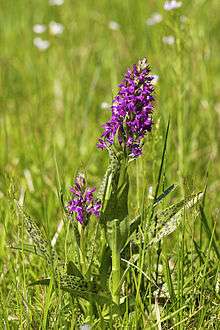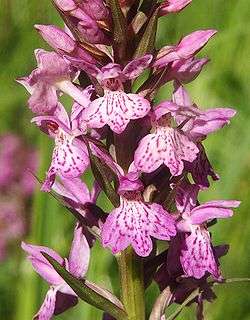Dactylorhiza majalis
| Dactylorhiza majalis | |
|---|---|
 | |
| Scientific classification | |
| Kingdom: | Plantae |
| (unranked): | Angiosperms |
| (unranked): | Monocots |
| Order: | Asparagales |
| Family: | Orchidaceae |
| Tribe: | Orchideae |
| Genus: | Dactylorhiza |
| Species: | D. majalis |
| Binomial name | |
| Dactylorhiza majalis (Rchb.) P.F. Hunt & Summerh. | |
Dactylorhiza majalis (western marsh orchid, broad-leaved marsh orchid, fan orchid, common marsh orchid, or Irish marsh orchid) is a terrestrial Eurasian orchid.[1][2][3][4][5]
The western marsh orchid grows mainly in nitrogen-poor marsh areas that consist of several plant communities. More rarely, it is found in fens. Its flowering period begins at lower elevations as early as the beginning of May and ends in higher elevations at the end of July. The lowest blossoms usually open even before the stem has reached its full height.
Description

The western marsh orchid is usually 15 to 40 cm (6 to 15.5 in) tall, though some specimens may reach 60 cm (2.0 ft). Three to eight dark spotted leaves are distributed on the stem, which is hollow. The lower leaves are ovate to lanceolate and 6 to 18 cm (2.5 to 7 in) long and 1.5 to 3.5 cm (⅝ to 1⅜ in) wide. The upper leaves are increasingly smaller and more lanceolate. The bracts are about as long as the blossom and cover it before it blooms. The densely flowered inflorescence, which is 4 to 15 cm (1.5 to 6 in) long, is at first conical, but distinctly cylindrical when in full blossom. The seven to forty blossoms are colored purplish red, rarely light pink or white. The lateral tepals of the external circle of the perianth stand obliquely or vertically upright. They are 7 to 12 mm (¼ to ½ in) long and 2.5 to 5 mm (⅛ to 3⁄16 in) wide. The middle tepal is smaller and forms a "helmet" together with the two lateral tepals of the internal circle. These are 6 to 11 mm (¼ to 7⁄16 in) long. The trilobate lip is 5 to 10 mm (3⁄16 to ⅜ in) long and 7 to 14 mm (¼ to 9⁄16 in) wide. The shape and pattern of the lips are variable. In the lighter central area of the lip the markings are made up of lines, streaks, or dots. The spur is bent slightly downwards and is not quite as long as the ovary. The tuber has a palmate division and an irregular shape.
The western marsh orchid has a karyotype of two sets of forty chromosomes. The seed of this orchid contains no endosperm for the embryo. Therefore, germination can take place only by means of infection with a root fungus (mycorrhiza).

Taxonomy
In 1828 Ludwig Reichenbach described the western marsh orchid as Orchis majalis. The name became the basionym after Peter Francis Hunt and Victor Samuel Summerhayes transferred the species to the genus Dactylorhiza in 1965. Sometimes the name Dactylorhiza fistulosa is used, but since this description is not valid, the name cannot be used despite its earlier publication in 1794 as Orchis fistulosa.
Many synonyms have been published:[6]
- Orchis majalis Rchb.
- Dactylorchis majalis (Rchb.) Verm
- Orchis baltica (Klinge) A.Fuchs
- Dactylorchis baltica (Klinge) Verm.
- Dactylorhiza baltica (Klinge) N.I.Orlova
- Orchis longifolia Neuman
- Dactylorhiza ebudensis (Wief. ex R.M.Bateman & Denholm) P.Delforge
- Orchis francis-drucei Wilmott
- Dactylorhiza francis-drucei (Wilmott) Aver.
- Orchis kerryensis Wilmott
- Dactylorchis kerryensis (Wilmott) Verm.
- Dactylorhiza kerryensis (Wilmott) P.F.Hunt & Summerh.
- Dactylorhiza parvimajalis D.Tyteca & Gathoye
- Orchis occidentalis (Pugsley) Wilmott
- Dactylorchis occidentalis (Pugsley) Verm.
- Dactylorhiza occidentalis (Pugsley) P.Delforge
- Orchis sphagnicola Höppner
- Dactylorchis sphagnicola (Höppner) Verm.
- Dactylorhiza sphagnicola (Höppner) Aver.
- Dactylorchis hoeppneri (A.Fuchs) Verm.
- Orchis hoeppneri (A.Fuchs) Höppner ex Verm.
- Dactylorchis deweveri Verm.
- Dactylorhiza deweveri (Verm.) Soó
- Dactylorhiza hoeppneri (A.Fuchs) Soó
- Dactylorhiza sennia Vollmar
- Orchis traunsteinerioides (Pugsley) Pugsley
- Dactylorchis traunsteinerioides (Pugsley) Verm.
- Dactylorhiza traunsteinerioides (Pugsley) Landwehr
Subspecies, varieties and hybrids


- Subspecies and varieties
Many names have been proposed at the subspecies, variety and form levels, but as of June 2014 only the following are recognized:[6]
- Dactylorhiza majalis subsp. baltica (Klinge) H.Sund. – Finland, Germany, the Baltic Republics, Russia, Siberia, Kazakhstan
- Dactylorhiza majalis subsp. ebudensis (Wief. ex R.M.Bateman & Denholm) M.R.Lowe – Outer Hebrides of Scotland
- Dactylorhiza majalis var. francis-drucei (Wilmott) R.M.Bateman & Denholm – Scotland
- Dactylorhiza majalis var. kerryensis (Wilmott) R.M.Bateman & Denholm – western Ireland
- Dactylorhiza majalis subsp. majalis – widespread across much of Europe from Spain to Russia
- Dactylorhiza majalis subsp. occidentalis (Pugsley) P.D.Sell – Britain and Ireland
- Dactylorhiza majalis subsp. sphagnicola (Höppner) H.A.Pedersen & Hedrén – Scandinavia, Germany, France, Belgium, Netherlands
- Dactylorhiza majalis subsp. traunsteinerioides (Pugsley) R.M.Bateman & Denholm – Britain and Ireland
The western marsh orchid hybridizes quite commonly with other species of its genus.
- Dactylorhiza × aschersoniana (Dactylorhiza incarnata × D. majalis)
- Dactylorhiza × braunii (Dactylorhiza fuchsii × D. majalis)
- Dactylorhiza × dufftiana (Dactylorhiza traunsteineri × D. majalis)
- Dactylorhiza × godferyana (Dactylorhiza praetermissa × D. majalis)
- Dactylorhiza × kuehnensis (Dactylorhiza ruthei × D. majalis)
- Dactylorhiza × townsendiana (Dactylorhiza maculata × D. majalis)
- Dactylorhiza × rupertii (Dactylorhiza sambucina × D. majalis)
More rarely, hybrids with other genera (intergeneric hybrids) occur.
- ×Dactyloglossum drucei (Coeloglossum viride × Dactylorhiza majalis)
- ×Dactylodenia lebrunii (Dactylorhiza majalis × Gymnadenia conopsea)
Range
Dactylorhiza majalis is widespread across much of Europe and north-central Asia from Spain and Ireland to Siberia and Kazakhstan.[6]
In Germany the western marsh orchid is widespread but with several gaps. In many places, especially from western to northern Germany, it is extinct.
In Switzerland the western marsh orchid is also quite widespread. A significant gap is found south of the Aar between Aarau and Lake Neuchâtel.
Conservation
Although the western marsh orchid is commonly found in some regions, it is nevertheless protected as an orchid.
As with many marsh plants, the numbers of this species have been dwindling for quite some time. The main causes are the entry of nitrogen via fertilizer, drying out of the habitat, and intensive conversion to pasture. The western marsh orchid does not react so sensitively to changes in its habitat as for example the early marsh orchid, Dactylorhiza incarnata. It is usually the last of the native orchids to disappear. This tolerance makes it a still relatively common species.
References
- ↑ Ó. Sánchez Pedraja (2005). "Dactylorhiza Neck. ex Nevski". In C. Aedo & A. Herrero. Smilacaceae–Orchidaceae. Flora Iberica. 21. Real Jardín Botánico, CSIC, Madrid. pp. 94–111. ISBN 8400083059.
- ↑ N. Griebl (2008). "Vorkommen und verbreitung der gattung Dactylorhiza in Österreich". Berichte aus den arbeitskreisen heimische orchideen. 25 (2): 80–118.
- ↑ Henrik Æ. Pedersen & Mikael Hedrén (2010). "On the distinction of Dactylorhiza baltica and D. pardalina (Orchidaceae) and the systematic affinities of geographically intermediate populations". Nordic Journal of Botany. 28 (1): 1–12. doi:10.1111/j.1756-1051.2009.00450.x.
- ↑ Mikael Hedrén, Sofie Nordström & Richard M. Bateman (2011). "Plastid and nuclear DNA marker data support the recognition of four tetraploid marsh orchids (Dactylorhiza majalis s.l., Orchidaceae) in Britain and Ireland, but require their recircumscription". Biological Journal of the Linnean Society. 104 (1): 107–128. doi:10.1111/j.1095-8312.2011.01708.x.
- ↑ Henrik Ærenlund Pedersen (2004). "Dactylorhiza majalis s.l. (Orchidaceae) in acid habitats: variation patterns, taxonomy and evolution". Nordic Journal of Botany. 22 (6): 641–658. doi:10.1111/j.1756-1051.2002.tb01921.x.
- 1 2 3 Kew World Checklist of Selected Plant Families
This article incorporates text translated from the corresponding German and French Wikipedia articles as of 4 February 2006.
External links
 Media related to Dactylorhiza majalis at Wikimedia Commons
Media related to Dactylorhiza majalis at Wikimedia Commons- Dactylorhiza majalis at the Encyclopedia of Life

- Den virtuella floran Distribution
